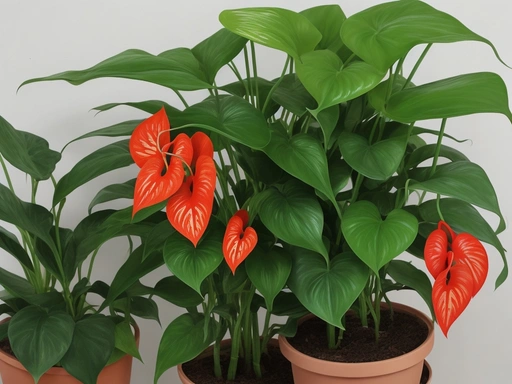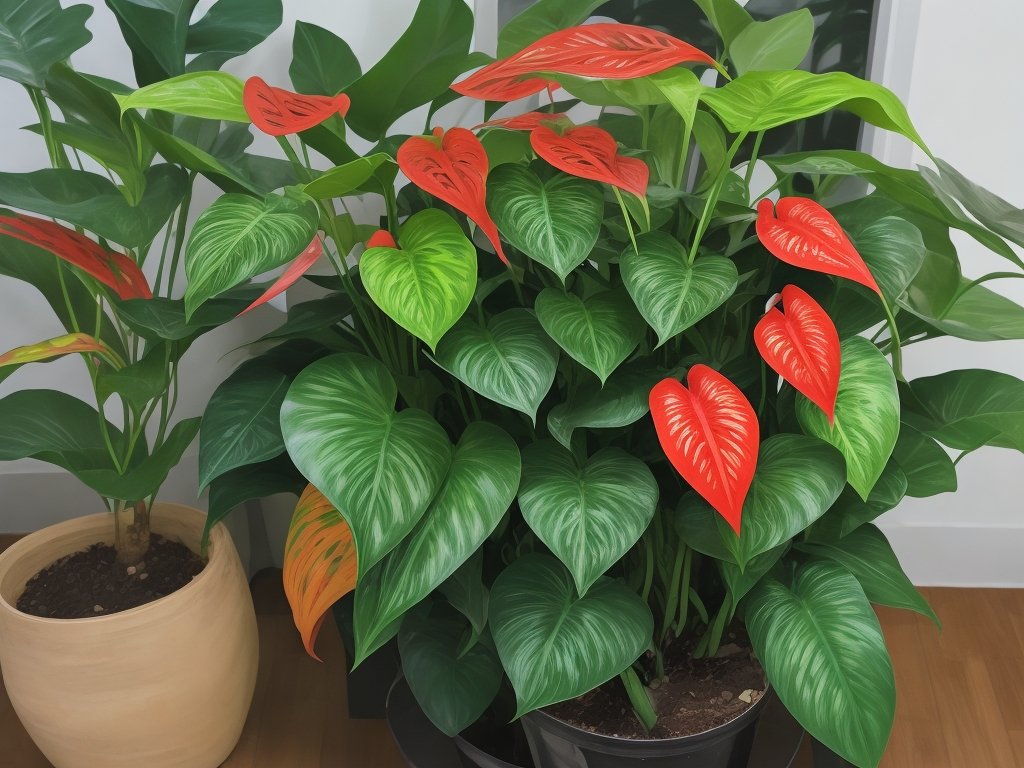Anthurium Pot Drainage: Tips for a Healthy and Happy Plant
Key Takeaways:
- Adequate drainage is crucial for healthy growth and development of Anthurium plants in pots.
- Poor drainage can lead to root rot, suffocation of the roots, and overall decline in plant health.
- Opt for well-draining potting mix and containers with drainage holes to ensure excess water can escape.
- Regularly monitor soil moisture levels and adjust watering frequency accordingly for Anthurium pots.
Welcome to the fascinating world of Anthurium pot drainage! Have you ever wondered why proper drainage is crucial for the health and vitality of your Anthurium plants? Well, you’re in the right place! In this article, I’ll guide you through the importance of drainage in Anthurium potting and how it benefits your plants.
We’ll also explore the signs of poor drainage to help you identify any issues.
Plus, I’ll share some valuable tips on enhancing drainage, proper watering techniques, and crucial mistakes to avoid. So, let’s dive in and give your Anthuriums the care they deserve!
| Factors | Importance | Effect on Anthurium | Recommendation |
|---|---|---|---|
| Container material | High | Affects water retention and drainage | Use clay or ceramic pots |
| Pot size | Medium | Affects root growth and water distribution | Choose a pot that allows for proper root development |
| Drainage holes | High | Allows excess water to escape | Ensure the pot has sufficient drainage holes |
| Potting mix | High | Affects moisture levels, aeration, and nutrient availability | Use a well-draining potting mix with good moisture retention |
| Frequency of watering | Medium | Affects soil moisture and root health | Water appropriately, ensuring the soil dries slightly between waterings |
| Watering method | Low | Affects water distribution and prevents waterlogging | Water at the base of the plant and avoid overhead watering |
What is Anthurium Pot Drainage?
Anthurium pot drainage refers to the ability of water to properly flow through the soil and exit the pot, preventing waterlogging and root rot.
Understanding the Importance of Drainage in Anthurium Potting
Proper drainage is crucial for Anthurium potting.
It allows excess water to escape, preventing root rot and overwatering.
Good drainage promotes healthy root growth and helps maintain the right moisture levels for Anthurium plants.
It’s important to choose the right pot, potting mix, and add drainage materials to ensure proper drainage in Anthurium pots.
How Does Proper Drainage Benefit Anthurium Plants?
Proper drainage benefits Anthurium plants by preventing waterlogged soil and root rot.
It allows excess water to flow out, ensuring the roots have access to oxygen and preventing suffocation.
It also helps regulate moisture levels, preventing overwatering and promoting healthy growth.

Signs of Poor Drainage in Anthurium Pots
Signs of poor drainage in Anthurium pots can include waterlogged soil, yellowing or wilting leaves, root rot, and an unpleasant odor. Additionally, you may notice slow growth, fungal growth, or the presence of pests.
Ensure proper drainage to avoid these issues.
How to Enhance Drainage in Anthurium Pots
To enhance drainage in Anthurium pots, use a pot with drainage holes and add materials like gravel or perlite to the potting mix.
Choosing the Right Pot for Anthurium Plants
Choosing the right pot for your Anthurium plants is important for their overall health and growth. Here are a few key factors to consider:
- Size: Select a pot that is slightly larger than the current root system of your Anthurium. This will allow room for growth without overwhelming the plant.
- Material: Opt for pots made of porous materials like terracotta or clay. These materials allow for better airflow and drainage, preventing waterlogged soil.
- Drainage Holes: Ensure that the pot has drainage holes at the bottom. This is crucial for preventing water from sitting in the pot and causing root rot.
- Depth: Anthuriums have shallow roots, so choose a pot that is wider rather than deeper. This will provide stability and prevent the plant from becoming top-heavy.
Remember, choosing the right pot is just the first step in providing optimal conditions for your Anthuriums. Pair it with the appropriate potting mix and proper watering techniques for best results.
Selecting the Appropriate Potting Mix for Anthuriums
When selecting a potting mix for Anthuriums, it’s important to choose one that provides good drainage. Look for a mix that is well-draining, yet retains enough moisture for the plant’s needs.
A mix composed of perlite, peat moss, and pine bark is often a good choice.
Avoid heavy or compacted soil that can lead to waterlogged roots. Focus on finding a mix that promotes a healthy root system and helps prevent waterlogged conditions.

Adding Drainage Materials to Anthurium Pots
To enhance drainage in Anthurium pots, you can add drainage materials such as rocks, pebbles, or perlite at the bottom of the pot.
These materials help create air pockets and prevent water from accumulating at the roots.
Be sure to layer them before adding potting mix to ensure proper drainage for your Anthurium plant.

Tips for Properly Watering Anthurium Plants
Proper watering is key for healthy Anthurium plants – here are some tips to help you get it right.
Moisture Requirements for Anthuriums
Anthuriums thrive in moderately moist soil. It’s important to keep the soil slightly damp, but not waterlogged.
Water the plant when the top inch of soil feels dry.
Avoid overwatering, as it can lead to root rot. Monitor the moisture levels regularly to maintain the ideal conditions for your Anthurium.

Watering Frequency and Techniques for Anthuriums
Water Anthurium plants when the top inch of soil feels dry to the touch. Water thoroughly, allowing water to drain out of the pot’s drainage holes.
Avoid overwatering, as it can lead to root rot.
Use room temperature water and avoid wetting the leaves. Adjust watering frequency based on the season and humidity.
Avoiding Overwatering and Underwatering Anthuriums
Overwatering and underwatering can both harm Anthuriums. To avoid overwatering, only water when the top inch of soil is dry.
Allow excess water to drain out.
Underwatering can be avoided by checking the moisture level regularly and watering when the soil feels dry.
Common Mistakes to Avoid with Anthurium Pot Drainage
Avoid using improper potting mixes for Anthuriums and neglecting to check for adequate drainage.
Using Improper Potting Mixes for Anthuriums
Using improper potting mixes for Anthuriums can lead to poor drainage and root rot.
It’s important to choose a well-draining mix that allows water to flow through easily.
Avoid using heavy soil or mixes that retain too much moisture.
Opt for a mix that includes materials like orchid bark, perlite, or coconut coir to promote proper drainage.
Neglecting to Check for Adequate Drainage
Neglecting to check for adequate drainage in your Anthurium pot can have detrimental effects on the health of your plant. Without proper drainage, excess water can accumulate and lead to root rot and other fungal diseases.
Always ensure that your pot has drainage holes and use well-draining potting mix to prevent waterlogging.
Ignoring the Signs of Poor Drainage in Anthurium Pots
Ignoring the signs of poor drainage in Anthurium pots can have detrimental effects on the health of your plants. Some signs to watch out for include waterlogged soil, yellowing or wilting leaves, and the presence of fungus or mold.
These indicators suggest that the roots are being subjected to excessive moisture, which can lead to root rot and plant decline.
It’s important to address poor drainage promptly to prevent long-term damage to your Anthurium plants.
Frequently Asked Questions
What is the best potting mix for Anthurium plants?
The best potting mix for Anthurium plants is a well-draining mix that retains some moisture but doesn’t become waterlogged. An ideal mix would consist of equal parts peat moss, perlite, and orchid bark.
This combination provides good aeration, moisture retention, and drainage for healthy Anthurium growth.
How often should I water my Anthurium plant?
Water your Anthurium plant when the top inch of the soil feels dry to the touch.
Overwatering can lead to root rot, so it’s important to let the soil dry out between waterings.
Aim for watering every 1-2 weeks, adjusting frequency based on your plant’s specific needs and environmental conditions.
Can I use any type of pot for Anthuriums?
No, you cannot use any type of pot for Anthuriums.
It is important to choose the right pot for these plants.
Opt for pots with drainage holes to ensure proper water drainage.
This will help prevent waterlogging and root rot, keeping your Anthuriums healthy.
How do I know if my Anthurium pot has poor drainage?
If your Anthurium pot has poor drainage, there are a few telltale signs to look out for. The first is waterlogged soil, which feels excessively wet and doesn’t drain properly.
Another sign is the presence of mold or fungus on the soil surface.
Additionally, if your plant’s leaves are yellowing, wilting, or developing root rot, it may indicate poor drainage in the pot. Keep an eye out for these signs to ensure your Anthurium is in a healthy environment.
Final Verdict
Proper drainage is essential for the health and growth of Anthurium plants. Adequate drainage prevents waterlogged soil, which can lead to root rot and other diseases.
By choosing the right pot and potting mix, and adding drainage materials, you can greatly improve drainage in Anthurium pots.
Additionally, understanding the moisture requirements and watering techniques for Anthuriums will help prevent overwatering or underwatering. Avoid common mistakes such as using improper potting mixes and neglecting to check for adequate drainage.
By following these tips, you can ensure that your Anthurium plants thrive and flourish.







